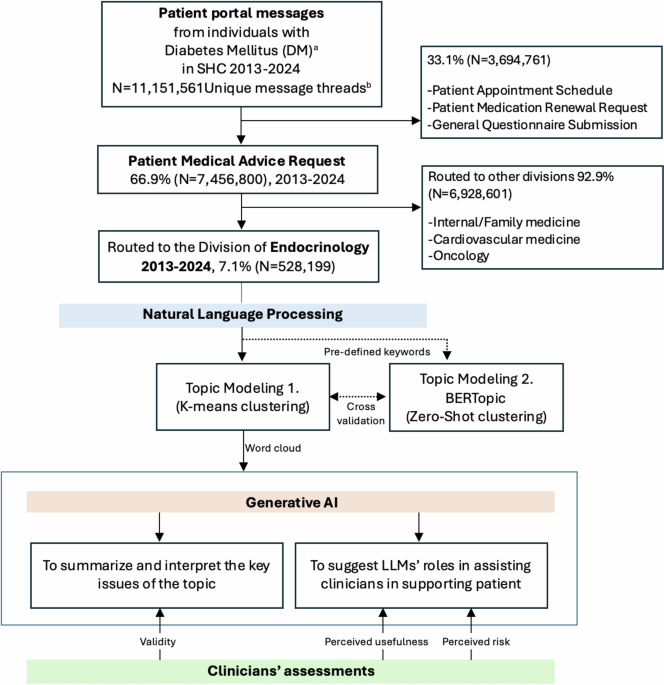Examining associations of digestive system cancer with hypertension and diabetes using network analysis in older patients
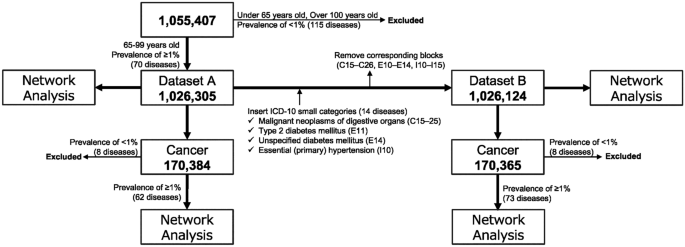
Baseline characteristics of patients
In analysis dataset A, which included 1,026,305 patients (Fig. 1), the average age was 76.16 years, with a mean of 3.18 comorbidities per patient. Among these patients, 533,280 (52.0%) were female (average age = 76.9 years; average number of comorbidities = 3.09), and 493,025 (48.0%) were male (average age = 75.3 years; average number of comorbidities = 3.28). The age distribution showed that 477,455 patients (46.5%) were aged between 65 and 74 years (average age = 69.5 years; average number of comorbidities = 2.90), whereas 548,850 patients (53.5%) were aged ≥ 75 years (average age = 82.0 years; average number of comorbidities = 3.43; Table 1).
Regarding disease prevalence, 225,614 patients (6.91%) had malignant neoplasms; 644,153 patients (19.71%) had diseases of the circulatory system, including essential hypertension and type 2 diabetes; and 486,917 patients (14.90%) had diseases of the digestive system (Fig. 2).
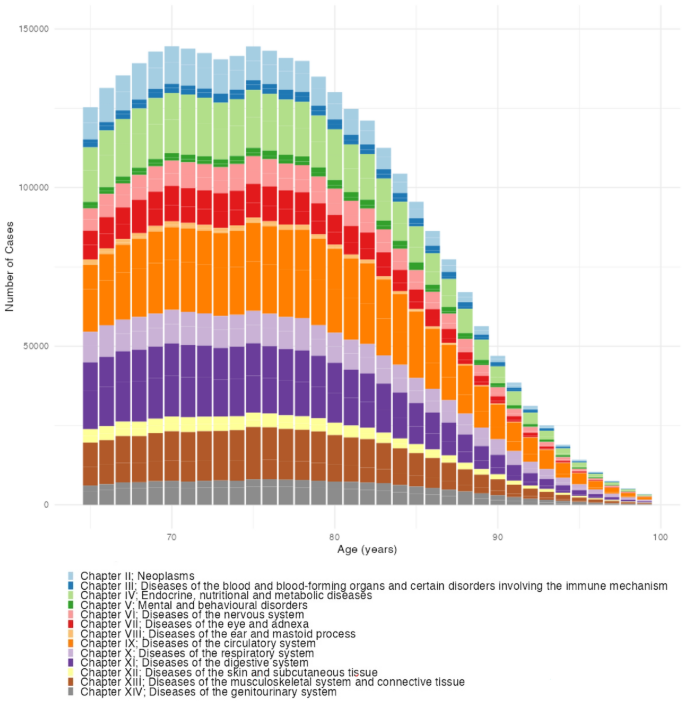
Number of patients in the cohort categorized according to age and International Classification of Disease codes.
Multimorbidity network
The network analysis results for dataset A revealed a network density of 0.52, with 70 nodes and 1,258 edges (Fig. 3).
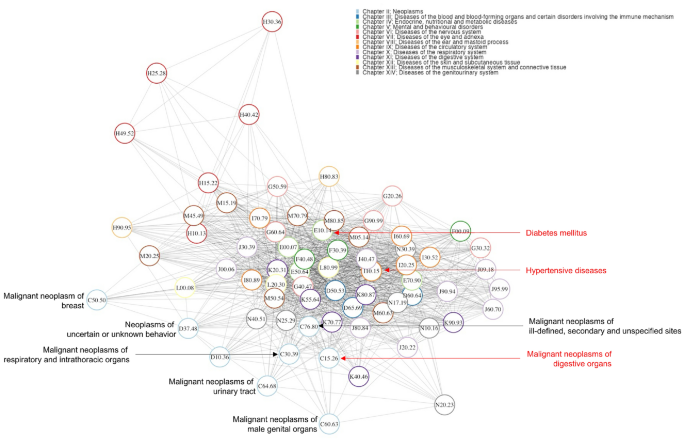
Multimorbidity network of all patients. Notes: The outlines of the nodes are color-coded according to the respective chapters of the ICD-10.
Hypertension (I10–15) was connected to 50 other diseases, with a degree centrality of 72.5% (50/69), ranking 14th among 70 diseases. Among the malignant neoplasms associated with hypertension, one was identified: malignant neoplasm of the digestive organs (Fig. 4). The association (OER) between hypertension and malignant neoplasms of the digestive organs was 1.17 (95% CI 1.15–1.19).

Relationships between various cancers, hypertension, and diabetes. Notes: Edges originating from diabetes mellitus are depicted in red, whereas edges originating from hypertensive diseases are depicted in blue.
Diabetes mellitus (E10–14) was connected to 55 other diseases, with a degree centrality of 79.7% (55/69), ranking 6th among the 70 diseases. Three malignant neoplasms were associated with diabetes mellitus: malignant neoplasms of the digestive organs, urinary system, and ill-defined or unknown sites, including secondary sites (Fig. 4). The associations (OER) were as follows: malignant neoplasms of the digestive organs, 1.43 (95% CI 1.41–1.46); urinary system, 1.07 (95% CI 1.01–1.12); and ill-defined or unknown sites, including secondary sites, 1.18 (95% CI 1.14–1.22). The highest association was observed for malignant neoplasms of the digestive organs. Notably, the association (OER) with malignant neoplasms of the digestive organs was stronger for diabetes mellitus than for hypertension.
Malignant neoplasms of the digestive organs (C15–26) were connected to 26 diseases, with the highest association (OER) observed with malignant neoplasms of ill-defined or unknown sites, including secondary sites (C76–80), at 6.34 (95% CI 6.18–6.51). This was followed by associations with hemolytic anemia (D50–53), at 3.49 (95% CI 3.40–3.57), and other diseases of the digestive system (K90–93), at 3.26 (95% CI 3.13–3.39).
The cancer group in analysis dataset A included 170,384 patients with an average age of 75.6 years and average of 3.96 comorbidities. Of these, 73,158 (42.9%) were female (average age = 75.8 years; average number of comorbidities = 3.75) and 97,226 (57.1%) were male (average age = 75.4 years; average number of comorbidities = 4.11). Among these patients, 82,462 (48.4%) were aged between 65–74 years (average age = 69.6 years; average number of comorbidities = 3.59), whereas 87,922 (51.6%) were aged ≥ 75 years (average age = 81.3 years; average number of comorbidities = 4.30).
The cohort’s major disease distributions were as follows: malignant neoplasms of digestive organs (C15–C26), 63,822 (37.5%) patients; malignant neoplasms of respiratory and intrathoracic organs (C30–C39), 21,016 (12.3%) patients; malignant neoplasm of breast (C50), 13,679 (8.0%) patients; malignant neoplasms of male genital organs (C60–C63), 19,802 (11.6%) patients; malignant neoplasms of urinary tract (C64–C68), 11,671 (6.8%) patients; malignant neoplasms of ill-defined, secondary, and unspecified sites (C76–C80), 23,121 (13.6%) patients; neoplasms of uncertain or unknown behavior (D37–D48), 48,918 (28.7%) patients; diabetes mellitus (E10–E14), 26,416 (15.5%) patients; and hypertensive diseases (I10–I15), 33,267 (19.5%) patients. The network analysis (Fig. 5) revealed a network density of 0.81, with 62 nodes and 1,526 edges (Table 2).
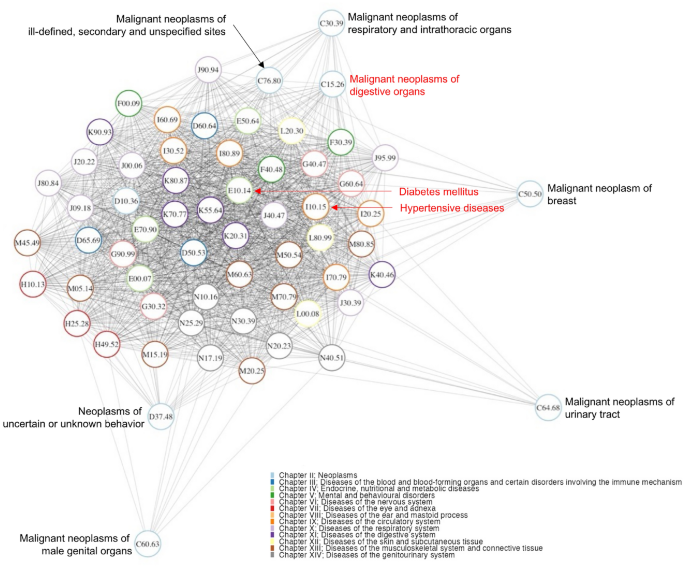
Multimorbidity network of all patients with cancer. Notes: The outlines of the nodes are color-coded according to their respective chapters of the ICD-10.
The multimorbidity network showed that hypertension (I10–15) was connected to 58 diseases, with a degree centrality of 58/61 (95.1%), the fifth highest among the 62 diseases. Four types of malignant neoplasms were associated with hypertension: malignant neoplasms of digestive organs (OER = 1.30; 95% CI 1.28–1.33); malignant neoplasms of ill-defined, secondary, and unspecified sites (OER = 1.11; 95% CI 1.08–1.15); malignant neoplasms of respiratory and intrathoracic organs (OER = 1.08; 95% CI 1.05–1.12); and malignant neoplasms of urinary tract (OER = 1.06; 95% CI 1.01–1.11; Fig. 4). The strongest association was observed with malignant neoplasms of the digestive organs.
Diabetes mellitus (E10–14) was connected to 56 other diseases, with a degree centrality of 56/61 (91.8%), the 13th highest among the 62 diseases. Two types of malignant neoplasms were associated with diabetes: malignant neoplasms of digestive organs (OER = 1.35; 95% CI 1.32–1.38) and ill-defined, secondary, and unspecified sites (OER = 1.11; 95% CI 1.07–1.15; Fig. 4). The association between diabetes and malignant neoplasms of digestive organs was stronger than that between diabetes and malignant neoplasms of ill-defined, secondary, and unspecified sites. Additionally, the association (OER) between malignant neoplasms of digestive organs and diabetes was stronger than that between these cancers and hypertension.
Malignant neoplasms of digestive organs (C15–26) were connected to 32 other diseases. The association between malignant neoplasms of the digestive organs and other diseases of the digestive system (K90–93) was the strongest (OER = 2.13; 95% CI 2.03–2.23), followed by those between malignant neoplasms of digestive organs and diseases of the gallbladder, biliary tract, and pancreas (K80–87; OER = 1.90; 95% CI 1.86–1.96) and nutritional anemias (D50–53; OER = 1.76; 95% CI 1.72–1.81).
Detailed multimorbidity network
Analysis dataset B includes a total of 14 diseases: 11 malignant neoplasms of the digestive organs (C15–C25), type 2 diabetes (E11), unspecified diabetes mellitus (E14), and essential hypertension (I10). The network analysis results indicated a network density of 0.47, with 81 nodes and 1,536 edges (Figure S3).
Essential hypertension (I10) was connected to 58 other diseases, with a degree centrality of 72.5% (58/80), ranking 12th among the 81 diseases. It was associated with eight types of malignant neoplasms of the digestive organs, including malignant neoplasms of the stomach, colon, rectosigmoid junction, rectum, liver and intrahepatic bile ducts, gallbladder, other and unspecified parts of the biliary tract, and pancreas. The strongest association (OER) was between essential hypertension and malignant neoplasms of the liver and intrahepatic bile ducts, at 1.54 (95% CI 1.47–1.62).
Type 2 diabetes (E11) was connected to 59 other diseases, with a degree centrality of 73.8% (59/80), ranking 10th among the 81 diseases. Malignant neoplasms of the digestive organs connected to type 2 diabetes included nine diseases: malignant neoplasms of the stomach, small intestine, colon, rectosigmoid junction, rectum, liver and intrahepatic bile ducts, gallbladder, other and unspecified parts of the biliary tract, and pancreas. In other words, type 2 diabetes was connected to all malignant neoplasms of the digestive organs, excluding those of the esophagus and anus/anal canal. The strongest association (OER) was between type 2 diabetes and pancreatic malignant neoplasm, at 2.59 (95% CI 2.43–2.77).
The cancer group in analysis dataset B comprised 170,365 patients. The average age of the patients was 75.6 years, with an average of 4.00 comorbidities. Regarding sex distribution, 73,147 (42.9%) of the patients were female (average age = 75.8 years; average number of comorbidities = 3.78), and 97,218 (57.1%) were male (average age = 75.4 years; average number of comorbidities = 4.34). By age group, 82,449 (48.4%) patients were aged 65–74 years (average age = 69.6 years; average number of comorbidities = 3.62), whereas 87,916 (51.6%) were aged ≥ 75 years (average age = 81.3 years; average number of comorbidities = 4.34).
The distribution of major diseases in the cohort was as follows: malignant neoplasm of esophagus (C15), 4,910 (2.9%) patients; malignant neoplasm of stomach (C16), 21,703 (12.7%) patients; malignant neoplasm of small intestine (C17), 466 (0.3%) patients; malignant neoplasm of colon (C18), 18,330 (10.8%) patients; malignant neoplasm of rectosigmoid junction (C19), 671 (0.4%) patients; malignant neoplasm of rectum (C20), 7,741 (4.5%) patients; malignant neoplasm of anus and anal canal (C21), 168 (0.1%) patients; malignant neoplasm of liver and intrahepatic bile ducts (C22), 6,030 (3.5%) patients; malignant neoplasm of gallbladder (C23), 1,070 (0.6%) patients; malignant neoplasm of other and unspecified parts of biliary tract (C24), 2,333 (1.4%) patients; malignant neoplasm of pancreas (C25), 5,123 (3.0%) patients; type 2 diabetes (E11), 67,108 (7.8%) patients; unspecified diabetes mellitus (E14), 64,655 (7.6%) patients; and essential hypertension (I10), 188,621 (22.0%) patients.
The network analysis (Fig. 6) revealed a network density of 0.68, with 73 nodes and 1,775 edges.

Detailed multimorbidity network of all patients with cancer. Notes: The outlines of the nodes are color-coded according to their respective ICD-10 chapters.
The multimorbidity network revealed that essential hypertension (I10) was connected to 68 diseases, with a degree centrality of 68/72 (94.4%), the highest among the 73 diseases. Essential hypertension was associated with 10 types of malignant neoplasms of the digestive organs: esophagus, stomach, small intestine, colon, rectosigmoid junction, rectum, liver and intrahepatic bile ducts, gallbladder, other and unspecified parts of the biliary tract, and pancreas, excluding only the anus and anal canal. The associations (OER) between essential hypertension and the neoplasms are listed in Table 3. Malignant neoplasms of the liver and intrahepatic bile ducts had the strongest association with essential hypertension (OER = 1.72; 95% CI 1.64–1.81).
Type 2 diabetes (E11) was connected to 66 other diseases, with a degree centrality of 66/72 (91.7%), the fourth highest among the 73 diseases. Nine types of malignant neoplasms of the digestive organs were linked to type 2 diabetes: stomach, small intestine, colon, rectosigmoid junction, rectum, liver and intrahepatic bile ducts, gallbladder, other and unspecified parts of the biliary tract, and pancreas, excluding only the esophagus and the anus and anal canal. The associations (OER) between type 2 diabetes and neoplasms are summarized in Table 3. Malignant neoplasms of the pancreas had the strongest association with type 2 diabetes (OER = 2.45; 95% CI 2.29–2.62).
Malignant neoplasms of the digestive organs were connected to each other as shown in Fig. 7. Malignant neoplasms of the colon had the most connections to other diseases (38), followed by those of the liver and intrahepatic bile ducts (31), and the rectum (26). Malignant neoplasms of the anus/anal canal had the fewest connections (6), followed by those of the esophagus (14) and gallbladder (17).

Relationships between digestive system cancers, hypertension, and diabetes. Notes: Edges originating from type 2 diabetes are depicted in red, and edges originating from essential (primary) hypertension are depicted in blue.
link


